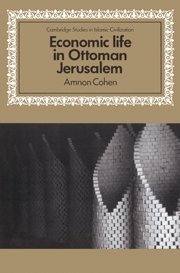Book contents
- Frontmatter
- Contents
- List of illustrations
- Note on transcription
- Map1
- Introduction
- 1 Butchers and meat consumption
- 2 Soap production and olive oil
- 3 Flour and bread
- Conclusion
- Note on abbreviations
- Note on weights, measures and monetary values
- Appendix 1 Meat prices in Jerusalem
- Appendix 2 Olive oil and soap prices in Jerusalem
- Appendix 3 Flour and bread prices in Jerusalem
- Appendix 4 A soap-factory in Jerusalem
- Notes
- Bibliography
- Subject index
- Geographical index
- Index of personal names
Conclusion
Published online by Cambridge University Press: 10 November 2010
- Frontmatter
- Contents
- List of illustrations
- Note on transcription
- Map1
- Introduction
- 1 Butchers and meat consumption
- 2 Soap production and olive oil
- 3 Flour and bread
- Conclusion
- Note on abbreviations
- Note on weights, measures and monetary values
- Appendix 1 Meat prices in Jerusalem
- Appendix 2 Olive oil and soap prices in Jerusalem
- Appendix 3 Flour and bread prices in Jerusalem
- Appendix 4 A soap-factory in Jerusalem
- Notes
- Bibliography
- Subject index
- Geographical index
- Index of personal names
Summary
This work has focused primarily on the town of Jerusalem and its local economy, with occasional references to contacts it maintained with other regions. Livestock was imported from the northern and north-eastern provinces, soap was exported to Egypt; rice, cloth, coffee and indigo were among the commodities imported from Egypt or sent from more remote provinces (Jedda) via Cairo. It was in the context of its relations with Egypt that we touched upon some of Jerusalem's links to other parts of Palestine: Jaffa served as the port of Jerusalem not only for European and other pilgrims, but for maritime traffic between Jerusalem and Cairo as well. Gaza was an important stopover for caravans taking the land route between the two cities.
The way from both Jaffa and Gaza to Jerusalem was over the single main road that wound up through the Judaean mountains all the way to the city gates. Passengers traveling uphill had to slow down and thus became relatively easy prey for bedouin and other robbers. The Ottoman authorities did not provide systematic military protection for the occasional caravans that followed this route and the only alternative was to deputize surrogate units. The Jerusalem court summoned the heads of two villages situated at critical points along the steepest part of the road (Qaryat al-ʿInab and Sarīs) and officially entrusted them with the task of ensuring the safety of human and commercial traffic to Jerusalem.
- Type
- Chapter
- Information
- Economic Life in Ottoman Jerusalem , pp. 119 - 127Publisher: Cambridge University PressPrint publication year: 1989

